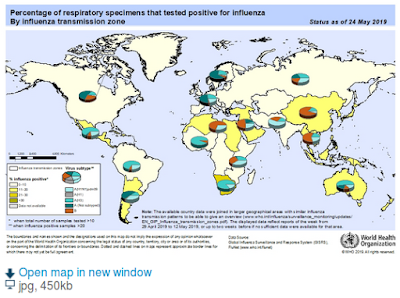#14,096
While flu circulates - albeit at low levels - year-round in the tropics, generally by early May the Northern Hemisphere's flu season has well ended and the Southern Hemisphere is still a month or two away from starting.
This year has been a bit different, with an unusually protracted flu season in the United States, and an equally surprisingly high level of Flu in Australia (see chart below) over their summer months.
Yesterday the World Health Organization published their latest global influenza report - current through May 12th - which found an increasingly quiet Northern Hemisphere, but continues to report early flu activity in many of the temperate zones south of the equator.
Influenza In South Australia: Credit Govt South Australia
H3N2 is the dominant flu subtype reported in Australia, New Zealand, and South Africa, while in South America H1N1 has been most frequently reported.The subtype that dominates can determine the severity of the flu season.
- First, because the flu vaccine for the southern hemisphere - selected last September - is expected to be more effective against H1N1 than against H3N2.
- And secondly, because H3N2 often produces a more severe flu season, and is known to hit the elderly more harshly than H1N1.
Influenza update - 342
27 May 2019 - Update number 342, based on data up to 12 May 2019
Information in this report is categorized by influenza transmission zones, which are geographical groups of countries, areas or territories with similar influenza transmission patterns. For more information on influenza transmission zones, see the link below:
Summary
- Influenza Transmission Zones
pdf, 659kb
In the temperate zones of the southern hemisphere, influenza detections increased overall.
National Influenza Centres (NICs) and other national influenza laboratories from 111 countries, areas or territories reported data to FluNet for the time period from 29 April 2019 to 12 May 2019 (data as of 2019-05-24 03:41:52 UTC). The WHO GISRS laboratories tested more than 80173 specimens during that time period. 7693 were positive for influenza viruses, of which 4383 (57%) were typed as influenza A and 3310 (43%) as influenza B.
- In Australia and New Zealand influenza detections were predominantly influenza A(H3N2) and influenza B viruses.
- In South Africa, predominantly influenza A(H3N2) viruses were detected.
- In South America, influenza A(H1N1)pdm09 viruses predominated.
- In Southern Asia, influenza activity was low overall.
- In the Caribbean, Central American countries, and the tropical countries of South America, influenza and RSV activity were low in general.
- In Eastern, West and Middle Africa, influenza activity was low across reporting countries.
- In the temperate zone of the northern hemisphere influenza activity decreased overall.
- In North America and Europe, influenza activity was low overall.
- In North Africa, influenza detections were low across reporting countries.
- In Western Asia, influenza activity was low overall, but with continued detections in a few countries on the Arabian Peninsula.
- In East Asia, decreased but continued influenza activity was reported.
Of the sub-typed influenza A viruses, 707 (30.9%) were influenza A(H1N1)pdm09 and 1578 (69.1%) were influenza A(H3N2). Of the characterized B viruses, 63 (2.9%) belonged to the B-Yamagata lineage and 2075 (97.1%) to the B-Victoria lineage.
Detailed influenza update
Download PDF
(SNIP)
Countries in the temperate zone of the southern hemisphere
Increased influenza detections were reported from countries in the temperate zone of the southern hemisphere.
- In Oceania, Australia, ILI activity and influenza detections were higher compared to the same period in previous years.Increased detections of mainly influenza A(H3N2) viruses were reported. NewCaledonia reported detections of predominantly influenza A(H1N1)pdm09 viruses. New Zealand reported increased detections of influenza A(H3N2) and influenza B Victoria lineage viruses.In New Zealand, ILI activity increased but remained below baseline. Influenza-associated hospitalizations also increased.
- South Africa reported increased influenza detections with predominantly influenza A(H3N2) and increased ILI activity. The season started in week 18 when influenza detections increased above the seasonal threshold.
- In South America, influenza detections increased above baseline and ILI activity increased in Chile, with influenza A(H1N1)pdm09 predominant among influenza detections. In Paraguay, influenza detections, of predominantly influenza A(H1N1)pdm09, and ILI increased slightly but remained around the baseline while RSV detections increased. Influenza detections were low in Argentina, Brazil and Uruguay.

